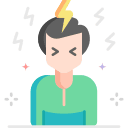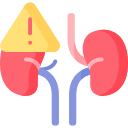DOXEPIN
THERAPEUTICS
Class
- Neuroscience-based Nomenclature: serotonin, norepinephrine multimodal (SN-MM)
- Tricyclic antidepressant (TCA)
- SNRI (dual serotonin and norepinephrine reuptake inhibitor)
- Antihistamine
DOXEPIN commonly prescribed for
(Bold for FDA approved)
 How DOXEPIN works
How DOXEPIN works
At antidepressant doses:
• Boosts neurotransmitters serotonin and norepinephrine
• Blocks serotonin reuptake pump (serotonin transporter), presumably increasing serotonergic neurotransmission
• Blocks norepinephrine reuptake pump (norepinephrine transporter), presumably increasing noradrenergic neurotransmission
• Presumably desensitizes both serotonin 1A receptors and beta adrenergic receptors
• Since dopamine is inactivated by norepinephrine reuptake in frontal cortex, which largely lacks dopamine transporters, doxepin can thus increase dopamine neurotransmission in this part of the brain
• May be effective in treating skin conditions because of its strong antihistamine properties ---- At hypnotic doses (3–6 mg/day):
• Selectively and potently blocks histamine 1 receptors, presumably decreasing wakefulness and thus promoting sleep
How long until DOXEPIN works
• May have immediate effects in treating insomnia or anxiety
• Onset of therapeutic actions in depression is usually not immediate, but often delayed 2–4 weeks
• If it is not working within 6–8 weeks for depression, it may require a dosage increase or it may not work at all
• May continue to work for many years to prevent relapse of depressive symptoms
• May also work long-term for insomnia (studied for up to 12 weeks)
SIDE EFFECTS
 Notable Side Effects
Notable Side Effects
----- Antidepressant Doses -----
• Blurred vision, constipation, urinary retention, increased appetite, dry mouth, nausea, diarrhea, heartburn, unusual taste in mouth, weight gain
• Fatigue, weakness, dizziness, sedation, headache, anxiety, nervousness, restlessness
• Sexual dysfunction, sweating
• Topical: burning, stinging, itching, or swelling at application site
•----- Hypnotic Doses -----
• Few side effects at low doses (3–6 mg/day), the most common being somnolence/sedation
 Life Threatening Side Effects
Life Threatening Side Effects
• Paralytic ileus, hyperthermia (TCAs + anticholinergic agents)
• Lowered seizure threshold and rare seizures
• Orthostatic hypotension, sudden death, arrhythmias, tachycardia
• QTc prolongation
• Hepatic failure, drug-induced parkinsonism
• Increased intraocular pressure, increased psychotic symptoms
• Rare induction of mania
• Rare activation of suicidal ideation and behavior (suicidality) (short-term studies did not show an increase in the risk of suicidality with antidepressants compared to placebo beyond age 24)
weight gain

common
sedation

common
What to do about DOXEPIN side effects
• Wait
• Wait
• Wait
• Lower the dose
• Switch to an SSRI or newer antidepressant
• Switch to another hypnotic
DOSING AND USE
usual dosage range
• 75–150 mg/day for depression
• 3–6 mg at bedtime for insomnia
 Dosage Forms
Dosage Forms
• Capsule 10 mg, 25 mg, 50 mg, 75 mg, 100 mg, 150 mg
• Solution 10 mg/mL
• Topical 5%
• Tablet 3 mg, 6 mg
long term use
• Safe
habit forming
• No
SPECIAL POPULATIONS
 Renal Impairment
Renal Impairment
• Use with caution
 Hepatic Impairment
Hepatic Impairment
• Use with caution – may need lower than usual adult dose
 Cardiac Impairment
Cardiac Impairment
• Baseline ECG is recommended (not for Silenor)
• TCAs have been reported to cause arrhythmias, prolongation of conduction time, orthostatic hypotension, sinus tachycardia, and heart failure, especially in the diseased heart
• Myocardial infarction and stroke have been reported with TCAs
• TCAs produce QTc prolongation, which may be enhanced by the existence of bradycardia, hypokalemia, congenital or acquired long QTc interval, which should be evaluated prior to administering doxepin
• Use with caution if treating concomitantly with a medication likely to produce prolonged bradycardia, hypokalemia, slowing of intracardiac conduction, or prolongation of the QTc interval
• Avoid TCAs in patients with a known history of QTc prolongation, recent acute myocardial infarction, and uncompensated heart failure
• TCAs may cause a sustained increase in heart rate in patients with ischemic heart disease and may worsen (decrease) heart rate variability, an independent risk of mortality in cardiac populations
• Since SSRIs may improve (increase) heart rate variability in patients following a myocardial infarct and may improve survival as well as mood in patients with acute angina or following a myocardial infarction, these are more appropriate agents for cardiac population than tricyclic/ tetracyclic antidepressants
• Risk/benefit ratio may not justify use of TCAs in cardiac impairment
 Elderly
Elderly
• Baseline ECG is recommended for patients over age 50 (not for Silenor)
• May be more sensitive to anticholinergic, cardiovascular, hypotensive, and sedative effects
• Low-dose doxepin (3–6 mg/day) has been studied and found effective for insomnia in elderly patients; recommended dose is 3 mg/day
• Reduction in the risk of suicidality with antidepressants compared to placebo in adults age 65 and older
 Children and Adolescents
Children and Adolescents
• Carefully weigh the risks and benefits of pharmacological treatment against the risks and benefits of nontreatment with antidepressants and make sure to document this in the patient’s chart
• Monitor patients face-to-face regularly, particularly during the first several weeks of treatment
• Use with caution, observing for activation of known or unknown bipolar disorder and/ or suicidal ideation, and inform parents or guardians of this risk so they can help observe child or adolescent patients
• Not recommended for use in children under age 12
• Several studies show lack of efficacy of TCAs for depression
• May be used to treat enuresis or hyperactive/impulsive behaviors
• Some cases of sudden death have occurred in children taking TCAs
• Initial dose 25–50 mg/day; maximum 100 mg/day
 Pregnancy
Pregnancy
• Effective June 30, 2015, the FDA requires changes to the content and format of pregnancy and lactation information in prescription drug labels, including the elimination of the pregnancy letter categories; the Pregnancy and Lactation Labeling Rule (PLLR or final rule) applies only to prescription drugs and will be phased in gradually for drugs approved on or after June 30, 2001
• Controlled studies have not been conducted in pregnant women
• Crosses the placenta
• Adverse effects have been reported in infants whose mothers took a TCA (lethargy, withdrawal symptoms, fetal malformations)
• Not generally recommended for use during pregnancy, especially during first trimester
• Must weigh the risk of treatment (first trimester fetal development, third trimester newborn delivery) to the child against the risk of no treatment (recurrence of depression, maternal health, infant bonding) to the mother and child
• For many patients this may mean continuing treatment during pregnancy for depression
 Breast Feeding
Breast Feeding
• Some drug is found in mother’s breast milk
• Significant drug levels have been detected in some nursing infants
• Recommended either to discontinue drug or bottle feed
• Immediate postpartum period is a high-risk time for depression, especially in women who have had prior depressive episodes, so drug may need to be reinstituted late in the third trimester or shortly after childbirth to prevent a recurrence during the postpartum period
• Must weigh benefits of breast feeding with risks and benefits of antidepressant treatment versus nontreatment to both the infant and the mother
• For many patients this may mean continuing treatment during breast feeding
Based on data Published online by Cambridge University Press
Compiled by Dr. Jash Ajmera